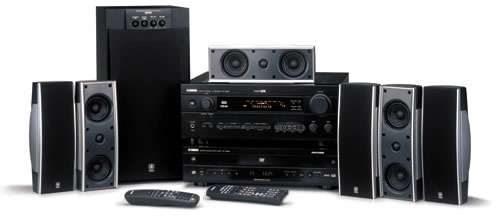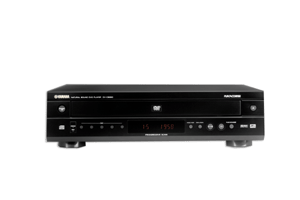| |||||||||
|
Introduction System Components The Yamaha YHT-941 is a component system rather than a single unit receiver/player. The receiver is the HTR-5660, a 6 channel receiver with a very respectable feature set and a very simple universal remote. The system uses the DV-C6660 DVD changer as a capable audio and video source. It is a five-disc changer that is compatible with both NTSC and PAL video software. The system comes with six identical looking satellites with 5 NS-AP5400S for the L, R, RS, LS, and rear channels. One of the boxes is marked NS-AP5400C and is intended to be the front center channel. The YHT-941 uses the TST-SW205 subwoofer. It is a fairly substantial box with ample controls and connections. The system included a 10' RCA cable for the sub connection and 100 feet of light gauge speaker wire. One RCA cable to connect the DVD player to the receiver, and both AM and FM antennas for the tuner in the HTR-5660. Some rubber feet for the center and a few non skid pads for the surrounds were all that was left in the box. All of the components are available as individually purchased units, although the speakers are in groups of six; all of the others are available as individual purchases. Receiver The HTR-5660 has a variety of surround modes including DPL, DPL-II, Dolby Digital, DD EX, DTS, DTS-ES Matrix 6.1, Discrete 6.1, and a DTS Neo:6 Decoder. It also includes some of Yamaha's DSP technology in the CINEMA DSP mode, the Virtual CINEMA DSP mode, and the SILENT CINEMA DSP mode. The HTR-5660 has 96kHz/24-bit
DACs, and is equipped with a six-channel analog
input for an external decoder or a SACD/DVD-A input. Two component inputs,
with one component output, provide enough bandwidth to allow switching for
either DVD or your HDTV set top box. The unit also has S-Video connections
for all of the inputs and one for a DVR as well as the Monitor Out. The
HTR-5660 has four digital inputs, one coaxial, and three optical. The inputs
are selectable so you can mix and match, but having only one coaxial input
was a bit restrictive. I had to dig out a bunch of optical cables as I don't
use that many in my own system. This leads me to one of
my few complaints about this “System”. Yamaha put together a very good
package with this group of products. It would make sense to me for them to
have included the
two or three additional cables (one Optical, one 75 ohm Coaxial, and one
Component Video) so that it truly did require you to “Just Add Your TV” for a
complete system. This target market requires the industry to make it very
simple. There should have been at least one connector to make the digital
connection between the DVD player and the receiver for the audio stream. It
should be obviously marked, and it should be included! The receiver has five-way
binding posts which were a pleasant surprise. I was able to use my own
speaker wires with enough room to accommodate the rather large WBT Banana
Plugs I use. I was relieved that I did not have to run all of the surround
wires that came with the system on the floor. All of those wires would have tempted
my 4 year old reviewing partner beyond his current level of self restraint.
The HTR-5660 has a digital out for using a mini-disc or other digital
recording device. It also has outputs for using a separate PVR. The HTR-5660
also has a fully functional second zone that uses analog output only. The
remote can actually operate the second zone using repeaters and a proper setup code. The HTR-5660 has very good flexibility and ample features, many that were not too long ago, considered the basis for “Flagship” designation. Video up-conversion for Composite to S-Video, addressable inputs and outputs and a full compliment of surround modes. This receiver had reasonable power, driving my 4-6 ohm reference system to very good sound levels without seeming to break down or overheat. I was quite pleased with the sound and it was nice to see that the video switching was performing as well as the audio section. I was switching everything via S-Video to keep things consistent, and my video processor will only accept 480i. I use an 8” liquid coupled CRT projector set up for 1280 x 720 fed by a Faroudja NRS processor. It is my primary video display for everything from serious movie watching to "Dora The Explorer". Speaker setup includes crossover points and distances. The crossover point is fixed at 90 Hz for the large or small designation. Distance can also be set for all six speakers in either feet or meters. The low frequency signal can be split and sent to the sub only, the main speakers, or to both locations. The crossover frequency is 90 Hz so it is not necessary to adjust it at the subwoofer control panel. The receiver is fitted out in black and very subtle gold lettering which will fit in most systems without too much trouble. The display is still using the older orange colored back lighting, but it is not distractingly large. The remote included was
adequate for the Yamaha components, but it failed to operate my RP-82 DVD
player or my very fussy Panasonic TUS-20 HDTV st box. Now as most of us know,
the sat box does not even operate with its own remote half of the time, but
it is important that the remote work. In my household any remote that is not
“Point and Shoot” may as well be thrown away before my wife ever touches it.
If it does not work as advertised, it will be handed back to me with the same
look reserved for meter maids that are writing a ticket as you walk up to the
car. Speakers The first thing that I
put in was the David Gilmore DVD that has become one of my favorite pieces.
It has very good sound, and the picture quality is equally impressive. There
are a couple of scenes that are very challenging for the DVD player, and
unfortunately the DV-C6660 had a bit of trouble with artifacts in a few
places. There were also a few shots of strings that produced ringing. I have
been using these items as test material for the last eight months. I am
really tuned into their presence when they are not handled well by the DVD
player. While they were present they were not dramatic, and on a smaller
display would probably not draw as much attention. This piece gives you a lot of variety of instruments, as well as a full spectrum of male and female voices, from the dry somewhat gravely voice of Gilmore to the smooth sounding choir that accompanies them. The cello was surprisingly well reproduced, and it had the morose haunting tone that I was hoping to hear. The lap steel guitar comes off howling as if it were actually being punished by the slide as Gilmore wails on it. The rolling drum of wooden bars and leather is very clear in the beginning. I think that I would have to say that I was pleasantly surprised by the way the YTB-941 filled my room with sound that was not what I expected from the smallish speakers. As I pointed out above, it seems like this combination of equipment is a good match. We worked the audio
side over with a few other favorites including “Swing Live” the Chesky
recording of Bucky Pizzarelli,
Natalie Merchant's "Tiger Lilly", and the wonderful new Barbarito
Torres CD of the same name. The Torres piece highlights the fantastic string
work of one of There were some gaps in
the lower midrange, but realistically they were beyond the expected range of
these small speakers. Next up, for some
serious movie viewing, I watched the rocket chase sequence from "Behind Enemy Lines",
and the bottom shaking rumble as the jet is catapulted off the carrier deck was
substantial enough as were the thrust changes as the plane made the high G
turns. I was certainly sucked right into the sequence, which is as much about
the sound as it is about the picture. I was actually surprised at the
dynamic range that this system had. It seemed to hold together right up to
97 dB - 98 dB before it seemed to get crowded and struggle. Those of you who have read any of my other pieces know that I use a lot of animated features for content in my reviews. "Finding Nemo" came out during the last week of looking at these systems, and it was really fun to use it for this review. Both the sound and the image are exceptional, and we actually had a large group of friends over to watch the movie. All of them have seen numerous movies in our room. I did not tell any of them that we were listening to a review system. None of them even noticed that things were different. I think that speaks a bit about the value that this system represents to the consumer. There were even a few moments when I was thinking about keeping this system in my theater, selling all of my other gear, and taking a vacation for a month or so with the proceeds…… I snapped out of it though. Conclusions I think that the YHT-941 is one of the better small systems that I have listened to. I feel that the combination of components is well matched. It certainly would be a good option to a large system, and it only needs a good remote to make it really simple for the family to use. It does push the whole concept of Home Theater In a Box a bit though. I could get most of my regular gear into one box too, but it would have to be the size of a refrigerator. This system comes in a box that is the same size as most 32” Televisions come in. It is certainly going to provide you with a complete listening experience should you chose to add it to your system.
| |||||||||





